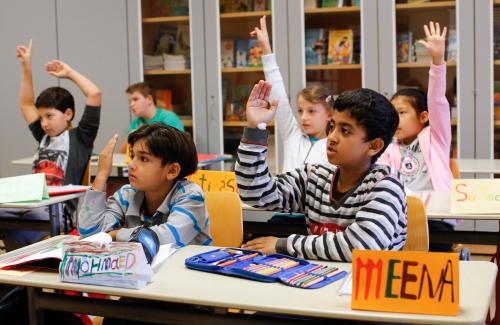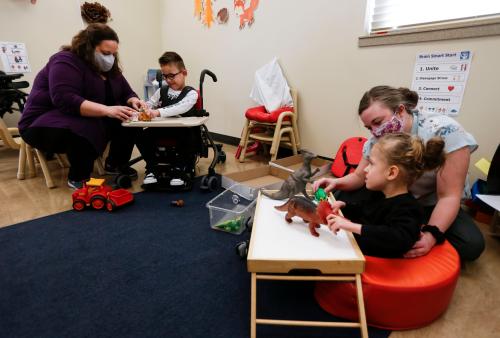Over the past 50 years, the United States has experienced the second-largest wave of immigration in its history. As a result, the share of recent immigrants (either foreign-born or children of foreign-born) in public schools reached 23% in 2015, with concentrations over 70% in several school districts in high-immigration states. These trends have generated a policy debate about the effects of immigration on public education and the perceived costs that immigrants may impose on public schools, local governments, and educational outcomes of the U.S.-born student population.
Better understanding the causal effects of immigrants on native students is therefore critical to inform these policy debates, yet there are two factors that complicate any effort to reveal this link. First, immigrant students are not randomly assigned to schools, and are more likely to enroll in schools educating students from disadvantaged backgrounds. Second, U.S.-born students, especially those from comparatively affluent families, may decide to leave when a large share of immigrant students move into their school district—a phenomenon commonly referred to as “native flight.” Both factors imply that simple correlations between immigrant exposure and native student outcomes will likely yield a more negative relationship than the true causal effect of immigrant exposure.
In a recent paper, we show how immigrant exposure affects the academic achievement of U.S.-born students. We do this with an analytical strategy that addresses both concerns above. We make use of rich, longitudinal education and health microdata from Florida. These data are exceptionally detailed. For example, they identify students’ siblings in school records, which enables us to use the within-family, across-sibling variation in immigrant exposure to study the effects of immigrants. In other words, we can compare the learning of U.S.-born siblings when one of those siblings happened to have more immigrants in their school cohort than the other sibling(s).
Figure 1, illustrating our main result, shows the relationship between immigrant exposure and native student math scores, and how this relationship changes when one accounts for native flight. We present the results for all U.S.-born students (black bars), along with the results for white (green bars) and Black students (blue bars) to demonstrate the effects for different student groups.
The results on the left of the figure are from a common model that accounts for the non-random sorting of immigrants (by comparing U.S.-born students with their peers in the same school), yet does not address native flight. (That is, we compare the academic performance of native students with their peers in the same school who have different levels of exposure to immigrants because they are enrolled in different grades.) On the right of the figure, we present the results from our preferred model where we rely on sibling comparisons. Several findings are worth highlighting.
First, when we move from our baseline model to sibling comparisons that account for native flight, we see that the relationship between immigrant exposure and U.S.-born student test scores changes from negative to positive.
Second, we find that this trend is entirely driven by students from more advantaged backgrounds. For example, for white students, we find a negative relationship between immigrant exposure and math achievement in models that fail to account for native flight compared to a sizable positive relationship in our preferred model. In contrast, for Black students, the positive effect of immigrant exposure remains virtually unchanged between the two models. This is consistent with the expectation that native flight is a bigger issue when examining the effects of immigrants on students from more advantaged backgrounds who can afford alternative schooling options in the wake of an immigrant influx.
In summary, we find no adverse effects of immigrant students on the academic achievement of U.S.-born students. This is true even when the immigrants’ academic achievement is lower than the U.S.-born students. In fact, we find significant benefits of having immigrant peers on the test scores of native students, especially among students from disadvantaged backgrounds.
This does not necessarily mean that immigrant students do not require public resources initially as they acquire English proficiency and get accustomed to the school system and life in a new country, which could have adverse effects on native students in the short-term—especially in the aftermath of large migrant inflows. That said, our findings suggest that, in the long run, the benefits of exposure to recent-immigrant peers, who are typically higher performing academically and have higher educational aspirations compared to more established immigrant generations, likely outweigh these potential short-term adverse effects.











Commentary
Do immigrants harm native students academically?
April 30, 2021